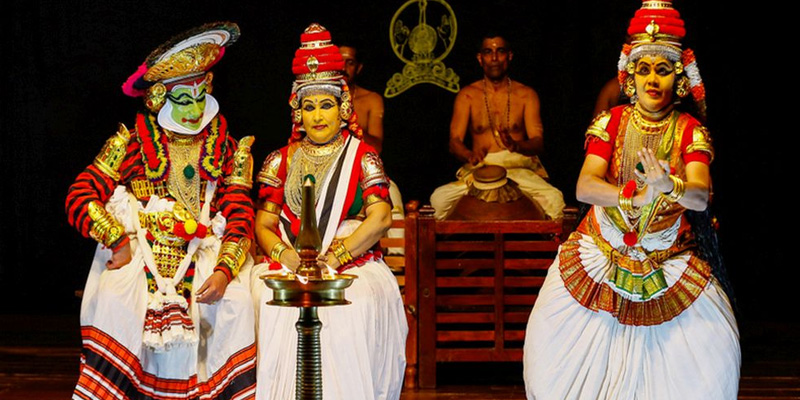Dating back to about 2000 years ago and drawing from the plays of eminent Sanskrit dramatists, Koodiyattam (alternatively written as ‘Kutiyattam’ and ‘Kudiyattam’) is a form of theatre from Kerala that claims great antiquity. It was declared one of the ‘Masterpieces of Oral and Intangible Heritage of Humanity’ by UNESCO in 2001, indicating the rich cultural and historic value that this theatre form holds within the ancient art traditions of India and the world. In Malayalam, the prefix koodi means ‘combined’ or ‘together’, and attam means ‘acting’. Therefore, the word ‘koodiyattam’ means ‘combined acting.’ Simply put, it is a theatre in which several characters come together on the stage. Koodiyattam was specifically performed by a community of male actors called the ‘Chakyars’, female performers called the ‘Nangiars’ and assisted by percussionists called the ‘Nambiars’. Within this context, it is to be noted that Koodiyattam was an umbrella term that referred to more than one art form, where Koodiyattam was the mode of theatre where both the Chakyars and Nangiars took part together; it also integrated ‘Nangiarkoothu’, the theatre which was exclusively performed by the Nangiars; and ‘Chakyarkoothu’, the verbal narrative drama of the Chakyars. This theatre form was performed in theatre houses known as ‘koothambalam’, which were permanent structures attached to some of the major temples in Kerala, such as the temples in Thrissur, Guruvayoor, and Thrippunithura to name a few.
Once restricted to the members of the Chakyar and Nangiar community and within the temple theatres as a ‘sacred art’, in 1949 and 1956, Guru Painkulam Rama Chakyar took a revolutionary step by performing Chakyarkoothu and Koodiyattam outside a temple. The art of Koodiyattam underwent a further transformation in 1965 when it was opened for training and performance to members of all communities throughout Kerala by the Kerala Kalamandalam with Guru Painkulam as its head. Along with Guru Painkulam, Ammanur Madhava Chakyar and Margi Sathi are other pioneers of this art form.
Though it broadly follows the rules of aesthetics as mentioned in Bharata’s Natyashastra, Koodiyattam has its defining characteristics in terms of theatrical conventions and methods of acting. The performance of Koodiyattam was codified through elaborate manuals of performance called Attaprakarams (describing the method of action, movement, gesture, and elaboration) and Kramadeepikas (mentioning stage production, use of costumes and payment to the artists). Koodiyattam includes the plays of most of the major playwrights in Sanskrit, including Bhasa, Harsha, Saktibhadra, Kulasekhara and Bodhayana. A distinctive feature of Koodiyattam is in its treatment of single Acts from Sanskrit plays as full-fledged plays therefore, the performances are based on these individual Acts and not on the whole play. For example, ‘Anguliyankam’ is the sixth act of Saktibhadra’s Ascharyachudamani and this one act alone would take several days to complete.
Koodiyattam is mainly the theatre of the actor, where the artist is offered the creative freedom to interpret the role they play. The essence of the theatrical communication is expressed through the ‘angika abhinaya’ which is assisted by orchestral support. The angika abhinaya involves dance movements, a language of gestures and a highly refined pattern of facial expressions. A Koodiyattam performer’s highlighting feature is their ability to showcase the art of facial expression with utmost perfection. Within this itself, the ‘netrabhinaya’ or the stylised acting through the eyes is the most significant element of Koodiyattam, in terms of its brilliant portrayal of any thought or feeling.
To give context to the nuances within Koodiyattam. We look at a rare and challenging scene called ‘Bharatavakyam’ or the actor’s speech, which comes at the end of the last Act of a play. It is considered to be a challenge because it involves the complete re-enactment of that Act on the last day of a performance which has lasted over 10 days or even more and, this is enacted by a single actor. Here, the actor has the role of the narrator who narrates the entire story using mudras and then, the dialogues of all the characters in their precise poses and ragas, lasting over several hours.
In order to unravel the multiple layers of meaning embedded within the text of the play, situations of poetic richness and dramatic potential are elaborated in Koodiyattam. The emphasis here is to explore the situation to its complete potential enabling the ‘rasa’ to reach its peak. In this context, the spectator is a creative participant who imaginatively identifies with the action, hence, the success of a Koodiyattam performance lies in the creation of reciprocity between the actor and spectator.

